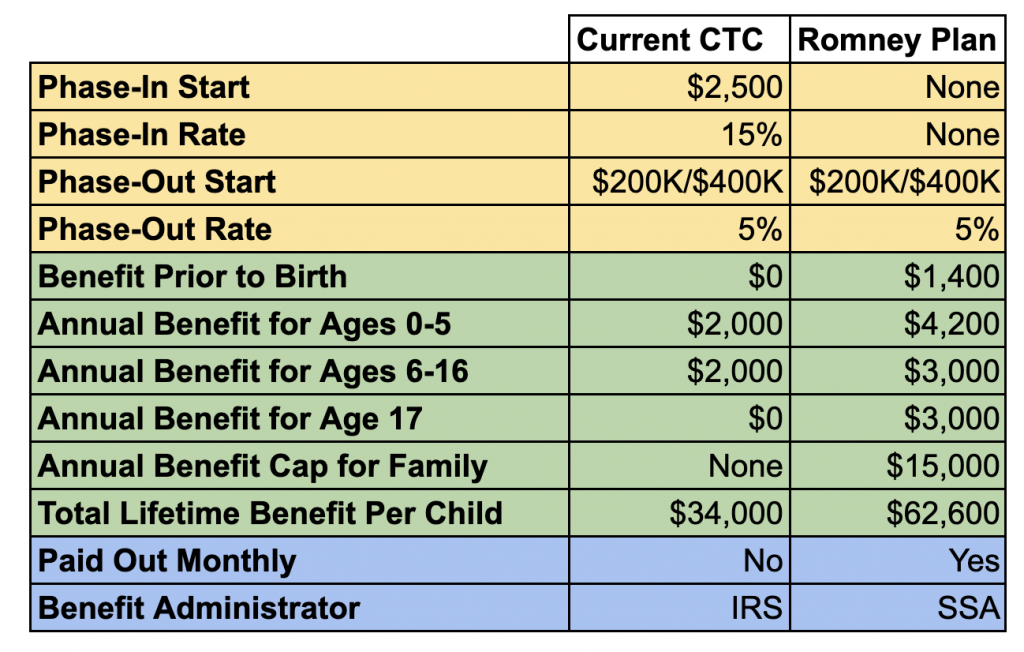Yesterday, Senator Mitt Romney renewed his push to create a child allowance under the Social Security Administration.
Now that it’s clear “Build Back Better” isn’t moving forward & with bipartisan opposition to extending the President’s ill-crafted Child Tax Credit, the Administration has an opportunity to actually work with Republicans & Democrats on lasting, fiscally-responsible family policy. pic.twitter.com/6ePaFrYciA
— Senator Mitt Romney (@SenatorRomney) December 20, 2021
In February of this year, I argued that Romney’s child allowance proposal was better than Biden’s Child Tax Credit (CTC) proposal. Nonetheless, the Biden CTC ended up being passed into law as part of the American Recovery Plan Act (ARPA), but only on a temporary one-year basis.
The Biden CTC has now expired and there is currently no plausible path for it to be renewed because Senator Joe Manchin has said he opposes the program. This means that Romney’s plan is our only real hope for enacting a child allowance during this Congress. If the House Democrats and every Senate Democrat except Joe Manchin comes out in support of the Romney bill, it could pass through reconciliation.
Insofar as the Biden CTC is now dead, it’s not worth rehashing why the Romney plan was better than it. Instead, the proper comparison is to the regular CTC that will resume operations next year. The following table provides such a comparison.

The Romney child allowance is better than the current CTC on nearly every level:
- The Romney benefit is available to the poorest children. The current CTC is not.
- The Romney benefit is nearly twice as generous as the current CTC over the course of a child’s lifetime.
- The Romney benefit is paid out monthly instead of as a lump sum at the end of the year.
- The Romney benefit uses the Social Security Administration, which is much more accessible to the poor than the IRS.
The current CTC beats the Romney proposal in only one area: it has no annual benefit cap. Under the Romney plan, a given family is not allowed to collect more than $15,000 per year in child benefits. Under the current CTC, there is no such cap. But at $2,000 per kid, only upper middle class families with 8 kids below the age of 17 would be better off under the current CTC than the Romney plan.
If you look at the Romney plan a bit creatively, another nugget stands out: it effectively contains a parental leave benefit that is better than what the Democrats were proposing in the Build Back Better legislation.
In the four months prior to birth, the Romney plan pays parents $350 per month, for a total of $1,400. The current CTC provides no money prior to birth and actually does not provide its first cash payout until the year after a child is born. Technically, this $1,400 benefit in Romney’s plan is a maternity grant benefit, not a parental leave benefit. In the best welfare states, parents are entitled to a maternity grant, a child allowance, and parental leave.
But in absence of the full benefit troika, the maternity grant could effectively be saved up by parents and then used like a parental leave benefit after their child is born.
If we analyze the Romney maternity grant as a parental leave benefit and stack it up against the parental leave proposal contained in the BBB bill, it looks like this:
A typical social democratic design combines these two approaches into a single scheme. So the way that would work is that you would say that all new parents are eligible for an amount equal to the income-replacement formula depicted in the red line or $1,400, whichever is greater.
But in this comparison, we are presented with a forced choice between a scheme that only has a $1,400 benefit or a scheme that only has this income-replacement formula. And in such a forced choice, the $1,400 Romney benefit clearly wins out.
Unlike the BBB plan, which uses a work history requirement to exclude 1 in 3 new mothers from the parental leave benefit, the Romney plan includes all new mothers. And distributively speaking, the Romney plan beats out the BBB plan for individuals with incomes below $20,000.
Of course, we aren’t actually currently presented with a choice between these two because the BBB plan is dead. It’s Romney or nothing, and a $1,400 maternity grant certainly beats nothing.
When Romney unveiled this proposal earlier this year, much was made of the fact that the Romney child allowance fully replaces the Child Tax Credit, the Head of Household filing status, the Child and Dependent Care Tax Credit, and the federal component of Temporary Assistance for Needy Families while also partially replacing the Earned Income Tax Credit. If you were looking for a nice rhetorical flourish about the plan, you could say that Romney was “cutting other benefits” or something to that effect.
In reality, having 5 different child cash benefits that weirdly overlap and clumsily duplicate one another is a bad way to do a welfare state. Consolidating all of these benefits into a single bigger monthly check issued by the Social Security Administration would be a massive improvement both administratively and distributively.
To be sure, the Romney plan is not perfect. Among other things, I would eliminate the annual benefit cap and also replace the phaseout with a tiny tax on all tax units with incomes above the phaseout thresholds (though the Romney phaseout is at least mercifully applied on the back end at tax time). But even with these flaws, it’s still quite a good benefit that is better than the status quo and, in my view, even better than the CTC the Democrats were trying to pass in the BBB legislation.
Democrats should work with Romney to pass this plan. Any quibbles they may have with the design should be fairly small and Romney has signaled some willingness to iron them out.

